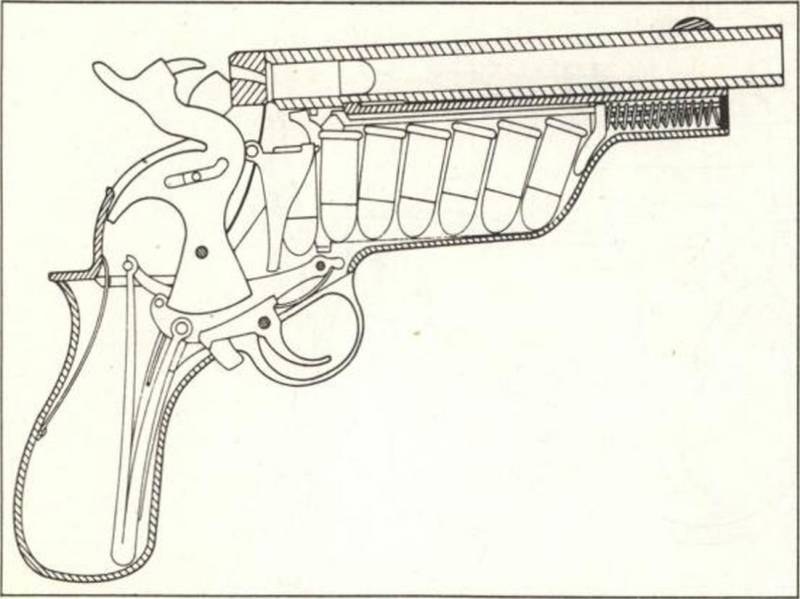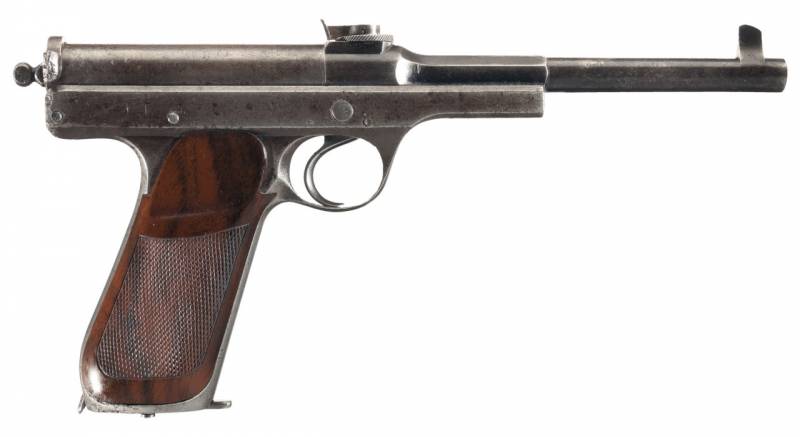Andreas Schwarzlose’s pistol: a great weapon, but not in time
November 6, 2021143
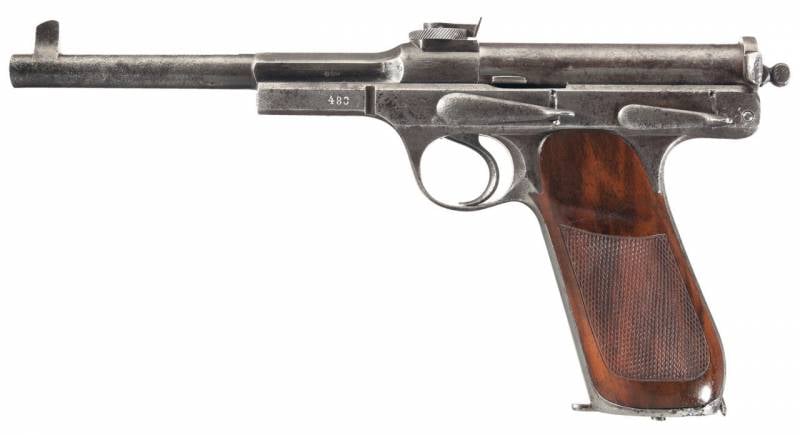
Pistol Schwarzlose M1898. Left view. Rockyland Arsenal Photo
And, each taking his own battle weapon,
and kindle fires on your towers,
they spent the whole night on guard.
Judith 7: 5
History firearms. VO readers are extremely interested in the materials about the Parabellum pistol, but this, however, is not surprising. They ask for a continuation of this topic, and it will be continued, but for now we will digress from it a little and tell you, dear readers, about another pistol of the late XNUMXth century, which would have looked quite modern even in the middle of the XNUMXth century …
Pistol M1898
It will be about a rather little-known pistol М1898, which was designed by Andreas Wilhelm Schwarzlose (1867-1936), more famous for the creation of his machine gun.
First, a little from his biography …
The future designer was born in the Berlin suburb of Charlottenburg, served in the army of the Austro-Hungarian monarchy, and all his experimental and production activities were associated with work at a factory in Berlin.
Although his name is most often mentioned in connection with the Schwarzlose machine gun, which was used primarily in the Austro-Hungarian army, his earliest developments concerned self-loading pistols.
It is significant that the path from the first and very imperfect samples to a very modern self-loading pistol took him only six years (1892-1898).
(High frequency ring saw manufacturer | TCBL)
](https://topwar.ru/uploads/posts/2021-11/1635858147_2_-pist.jpg)
The first Schwarzlose pistol of 1892 had a very specific device …
The first self-loading pistol had a strange and inconvenient design with an under-barrel magazine, in which the cartridges were placed vertically and, moreover, bullets down! The automatics of the pistol worked according to the Mannlicher scheme, that is, when the barrel moved forward, but it was more difficult, since it was necessary to turn the cartridges when they were fed into the barrel.
Schwarztose’s second self-loading pistol was patented in 1894 (German patent # 93.213; British patent # 9.490.14, May 1895), but it never seems to have gone beyond the drawing table.
He proposed a system with a long recoil of the barrel, a lever locking system and an annular lever (without trigger guard) control. Such a scheme would make it possible to cock the bolt with one hand, which was important for the cavalry. It is unknown why he gave up this pistol, or if there were others he worked on that were like him.
They failed anyway!
The Schwarzlose self-loading pistol (patent No. 93213 dated 5.08.1897/XNUMX/XNUMX) with a locking system with levers, which was clearly inspired by Hugo Borchardt’s pistol, did not reach the stage of embodiment in metal. Only now, unlike Borchardt and Luger, he placed the lever mechanism on it not from above, but from the side, so that the lever that rises in the process of firing would not flicker in front of the shooter’s eyes. He was loaded with five rounds from the clip. Interestingly, Schwarzlose worked on it not in Berlin, but in Suhl.
Realizing that the lever locking system is complex, and for a pistol this is far from the best option, Andreas Schwarzlose decided to use a scheme with a movable barrel and a rotating bolt (patents No. 94729 from 22.10.1897 and No. 100960 from 12.01.1899).
And so the result was an outwardly elegant and technically reliable pistol, which began to be called “Schwarzlose, model 1898” (also called “Standard Model”), which was produced in an amount of about 1 copies.
He also became his first truly successful development.
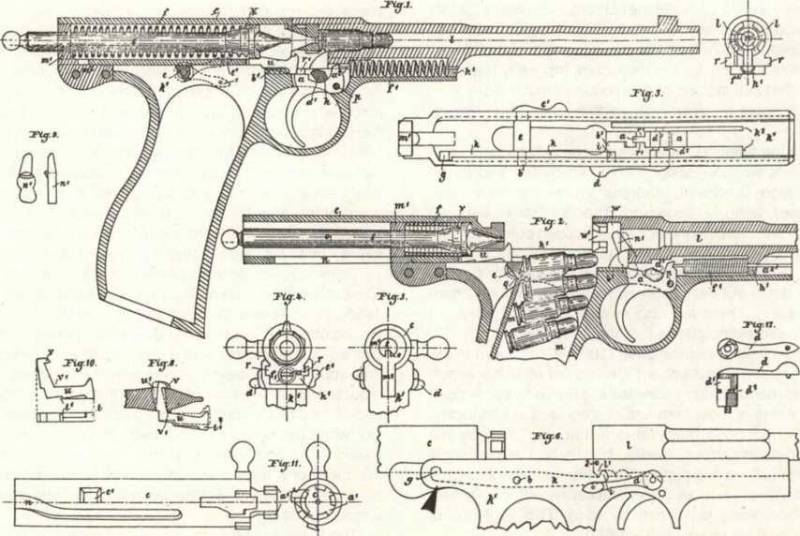
Diagram of the M1898 pistol from British patent No. 1934 1898. Pay attention to the bolt handle, exactly copied from the handle of Borchard’s pistol. But then the designer, apparently, thought a little and abandoned it, replacing it with more comfortable “ears” at the rear of the shutter. You could grab them with your index and middle fingers, and also with your middle and ring fingers, which was, of course, very convenient
Unfortunately, the military did not accept the Schwarzlose pistol, believing that it was, they say, too complicated and there were many details in it.
Why did they decide that?
It is unclear, especially since he understood only three parts, and there were even fewer parts in him than in other pistols similar to him.
Well, the commercial success of the 1898 pistol model of the year was hampered by the fact that the Mauser K96 had just appeared on the market. The market simply could not digest two pistols at once, since the weapon was unusual.
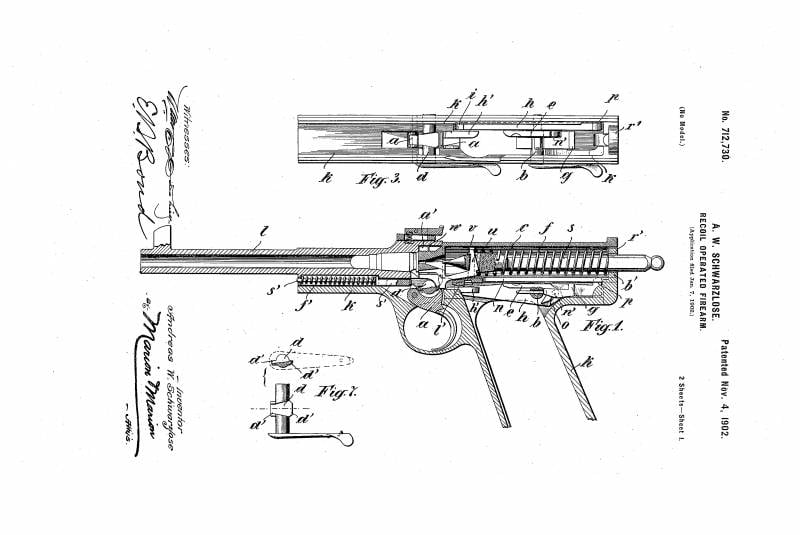
Improved circuit of the 1898 model of the 1902 US patent.
And nevertheless, Schwarzlose still managed to sell some of his pistols to Boers in Africa and Russia!
The Boers bought a lot of firearms in Germany, especially from the Mauser company (but the Maxim 37 mm guns, the famous “pom-poms” - in England). True, the Schwarzlose company before the end of the war was able to sell only a small batch of Standard pistols to the Boers.
But after a couple of years, his company was able to sell several thousand pistols to Russia. Not armies the fleet, police or gendarmerie - and Russian revolutionaries. For the revolution of 1905-1907. But these pistols were confiscated on the border with Russia and handed over to the Imperial Border Guard, which thus turned out to be armed exclusively with modern weapons!
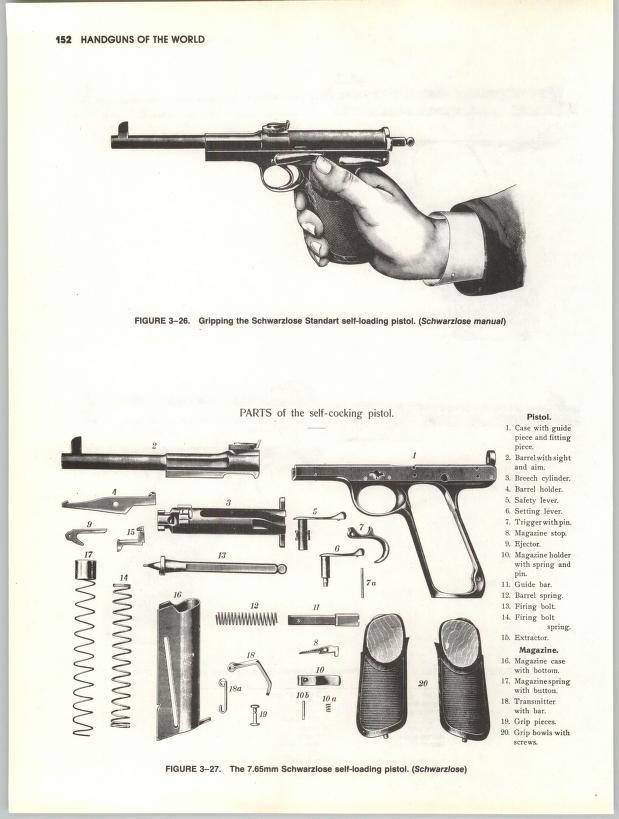
Fuse control and parts of the gun М1898. P. from the book: Ezell, Edward Clinton. Handguns of the World: Military Revolvers and Self-loaders from 1870 to 1945. Marboro Books. ISBN 978-0-88029-618-2
Noticing that Luger had finished the reloading lever mechanism to a sufficient degree of perfection, Schwarzlose tried to use it in his new pistol, positioning the lever approximately the same as in the P08 Parabellum pistol. For this sample, he received patents No. 6056 of 21.03.1900/140980/27.05.1903 and No. 1901 of XNUMX/XNUMX/XNUMX) and under the name “Self-loading pistol MXNUMX” offered it to the Dutch army.
But the Browning pistol FN1910 interested the Dutch military more …
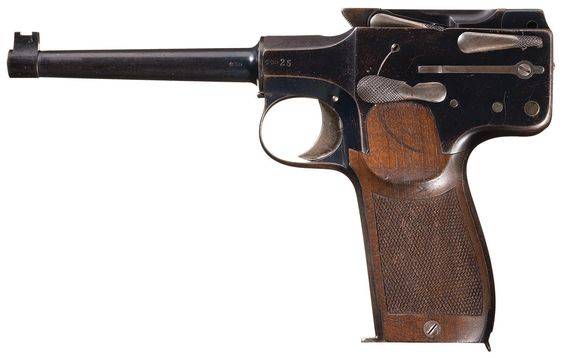
M1900 pistol. Left view. Rockyland Arsenal Photos
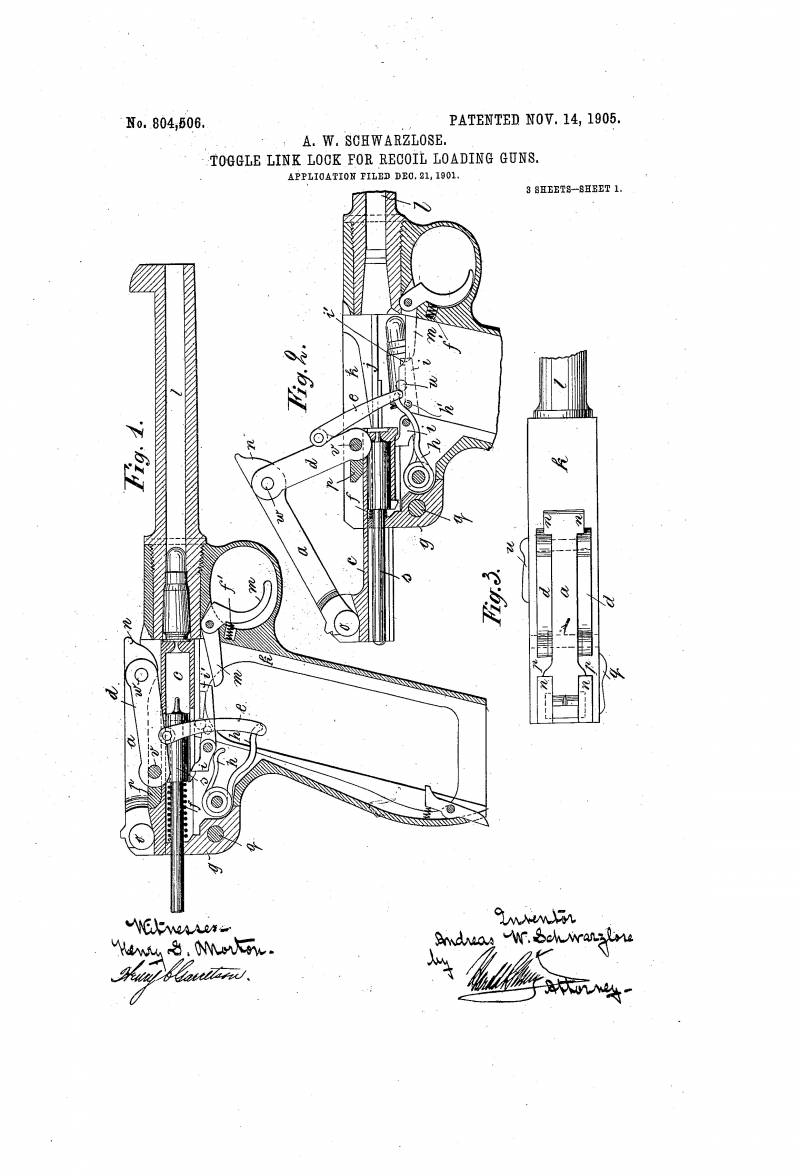
Schematic of a Schwarzlose pistol with a lever mechanism from US patent 1905.
As a result, Andreas Schwarzlose again reworked his pistol and on February 4, 1908 received a patent No. 194921 for it, and, as it turned out, it was this seemingly unremarkable pistol that turned out to be his most successful development.
The pistol received the designation M1909, its production was started and, moreover, this pistol began to be bought.
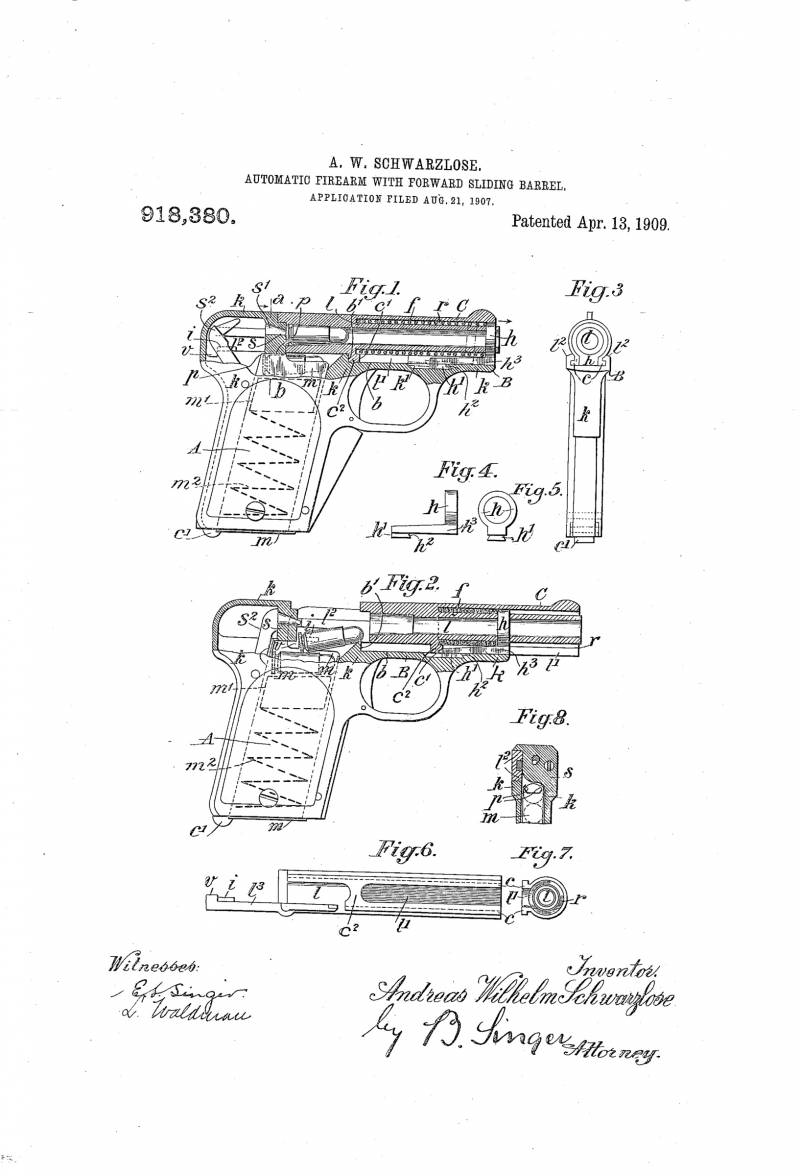
Schematic diagram of a 1909 Schwarzlose pistol from a US patent
It again used the forward movement of the barrel due to the pressure of the powder gases and the force of the bullet cutting into the rifling.
For three years, about 8 of these pistols were produced, with the Warner Arms Corporation setting up their production in the United States, and the Davis-Warrener Arms Corp. in 000-1917, they released another 1919.
The German Kaiser Wilhelm II himself did not disdain to order such a pistol, and he received serial number 1 (although, of course, he was not the first pistol of this brand produced). Apparently, the Kaiser finished off the wounded animals from him on the hunt.
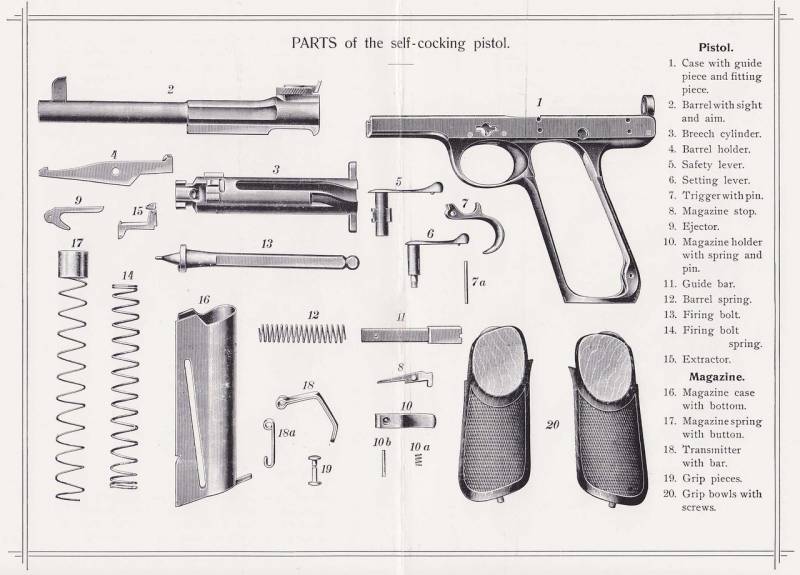
Complete disassembly of the M1909 pistol. Page from the technical manual
The production of Schwarzlose pistols was carried out by the company “A. V. Schwarzlose G. m. N. ”, founded by him together with the famous sugar manufacturer, scientist and traveler Max Scholler and Christian Kraft Hohenloe-Ehringen, who was engaged in mining business and politics.
After the defeat of Germany in the First World War, due to the demilitarization policy, the company was closed, and Andreas Schwarzlose had to work as an ordinary technical consultant. He lived in Berlin in the respectable area of Charlottenburg, where he died on April 18, 1936.
Breakthrough in the military field
Well, now let’s see what made this pistol so special from all others and why many gunsmiths considered (and do) consider it a real underrated breakthrough in the military field.
Look at the very first photo.
On its left side there are two levers one after the other. The far right is the shutter delay release lever, which was provided, and the shutter rose to it in its extreme rear position after all the cartridges in the magazine were used up.
To return the shutter to its place, it was necessary to lift this lever with your thumb up. It was also necessary to lift up the lever following it - the safety catch, which was very convenient.
But if you turn it forward 180 °, then the protrusions of this lever no longer interfere with the extraction of the barrel from the receiver, and then the bolt was removed in the same way.
Thus, the pistol was easily disassembled into only three parts!
As you can see, the pistol is simpler than ever, although it has a locking bolt.
Page from the technical manual. The barrel, first round, then octahedral, then round again, had protrusions in the lower part with which it entered the grooves of the receiver and could move along them back and forth. In the tide of the receiver, there was a barrel return spring under it.
Locking and unlocking the barrel of the pistol was carried out by turning the bolt and moving its four lugs behind the fixing protrusions of the nozzle on the barrel.
The number of lugs matters not only because the more there are not, the stronger the locking, but also because it determines the angle to which the shutter must be turned to lock. For example, if there are only two of them, then you need to rotate the shutter 90 °, if there are three - only 60 °. In this case, there were four of them, and the shutter rotated only 45 °.
The shutter was a tube about 25 mm in diameter. The inside of the bolt was bored to a diameter of 17,5 mm, so its weight was low. Inside was a massive drummer along with a drummer extractor and a combined shock-return spring.
A groove was made at the rear of the bolt, spiraling at the back by about 25 millimeters, and then straight by 50 millimeters, which guaranteed the necessary bolt rotation to unlock the barrel.
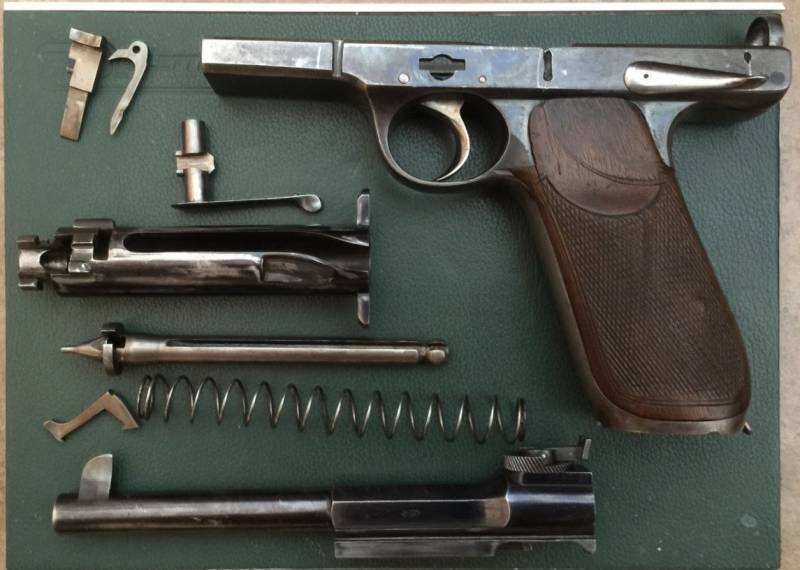
Disassembled M1898 pistol. The profiled groove and “ears” of the shutter are very clearly visible. Rockyland Arsenal Photos
The receiver housed all other parts of the pistol.
It is noteworthy that Schwarzlose limited himself to a minimum of springs, so there were only four of them, and all twisted: the return spring of the barrel, the magazine lock in the receiver, then the spring of the bolt and firing pin, and the rear sight spring, the last one, very tiny in size.
Among the disadvantages of many pistols with a movable bolt is the possibility of “flying” the bolt back, which, purely psychologically, often worries the shooter. In this pistol, although the bolt moves back, it cannot fly into the shooter’s face under any guise.
The fact is that in the back of the receiver, the Schwarzlose pistol had a detail that looked like the letter “i” or the signal wing of a railway semaphore. Its round part entered the bolt, and the leg - into the bolt groove. When fired, the barrel and bolt assembly retreated 19 millimeters, and the barrel stopped due to the full compression of the spring underneath.
The shutter was rotated 45 ° counterclockwise. And then he could freely move back another 50 millimeters. And the barrel, driven by its compressed return spring, returned back (that is, forward) by 4,8 millimeters until it was locked with a latch.

M1898 pistol. Top view. The sight is clearly visible (its location on the movable barrel was not the best solution, but there was simply nowhere else to put it) and the “ears” for which the bolt was pulled back when reloading. Photo of Rockydend Arsenal
The ejection of the spent cartridge case occurred towards the end of the recoil cycle, when the protrusion on the bolt actuated the ejector.
During the return stroke, the shutter was set in motion by a return spring. Moving forward, the bolt picked up the next cartridge from the store, fed it into the chamber, and then again turned and locked again.
Caliber - 7,63x25 mm Mauser.
Overall length - 273 mm.
Barrel length - 163 mm.
Weight (with an empty magazine) - 785 g.
The number of grooves is 4 clockwise.
The locking method is a rotating bolt, four lugs.
Magazine capacity - 7 rounds *.
*It is believed that the German army was never interested in the M1898 pistol, despite its advanced technology, only because they believed that the minimum magazine capacity of a self-loading pistol should be at least eight rounds.
It is interesting that the pistol from the very beginning was created precisely as a pistol, and not as a pistol-carbine, like Borchardt and Mauser pistols. But the conjuncture forced the designer to attach a butt holster to him. True, he placed its mount not at the end of the handle, but came up with the idea of fixing it with an emphasis on a semicircular protrusion between the handle and the receiver.
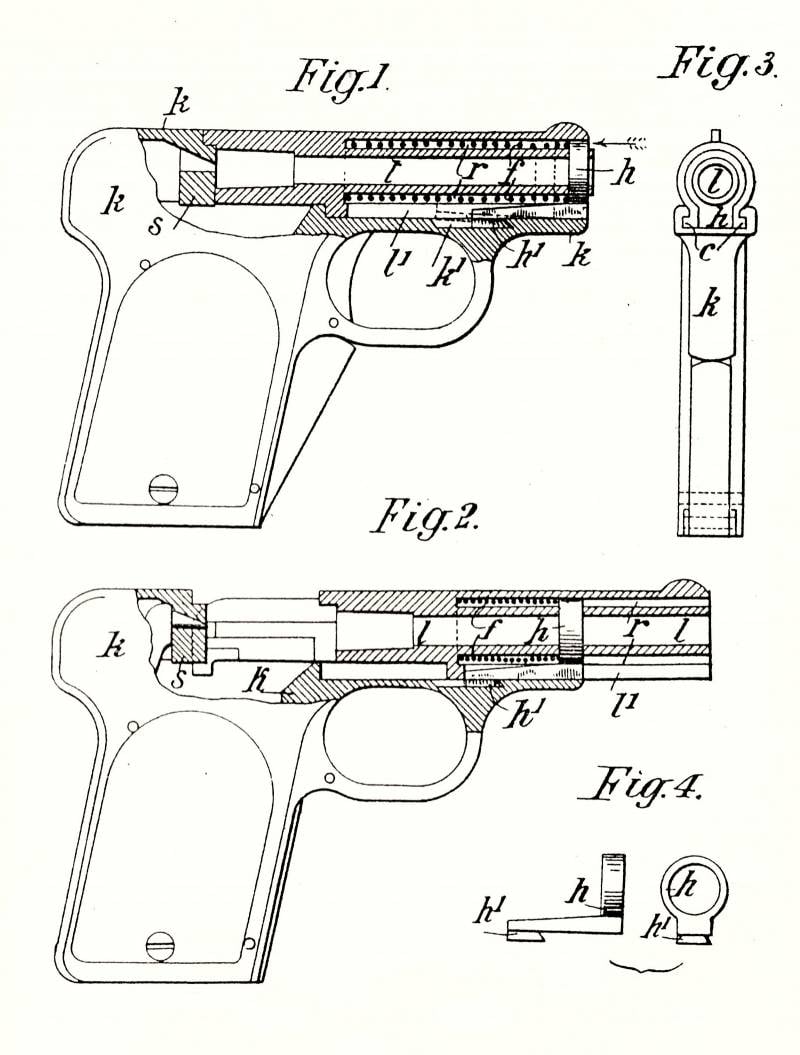
The scheme of action of the pistol М1909 from one of the patents. It is even difficult to imagine a simpler device for an automatic pistol. Moreover, since the rear part of the bolt during firing remained motionless, and the person simply did not have time to see the moving barrel, it seemed that everything in this pistol was generally motionless!
Comparison of these pistols of the late XNUMXth century:
Caliber (mm): “Standard” - 7,63x25; Borchardt - 7,65x25; Mauser - 7,63x25.
Bullet weight (grams): 5,5; 5,5-5,6; 5,0-5,95.
Bullet speed m / s: 450; 385; 443.
Bullet Energy (Joules): 550; 406; 539.
As you can see, the Schwarzlose pistol was at least not inferior in terms of its combat performance to pistols of a similar caliber that appeared at that time, but significantly surpassed them in terms of technical perfection and metal consumption of its production.
And nevertheless, nowhere, except here in Russia, he did not receive distribution, and in our country it was completely random.
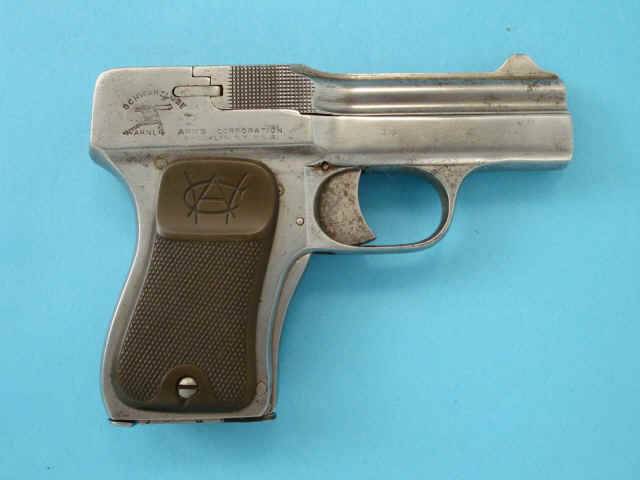
Pistol М1909. Pay attention to the logo. She says that the Schwarzlose machine gun by this time had already become well recognizable. Photo by Gregg Martin Auction Company
### PS
Anyone who is interested in the topic of early pistol designs can be recommended to refer to this publication: Ezell, Edward Clinton. Handguns of the World: Military Revolvers and Self-loaders from 1870 to 1945. Marboro Books. ISBN 978-0-88029-618-2.
